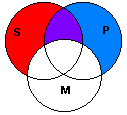An atheist is someone who doesn't answer "yes" to the question "do you believe in god(s)?"
So children, and agnostic who have no knowledge one way or the other are now called atheists.
This is an old atheist trick invented by none other than Antony Flew (whom I'm sure you are unfamiliar with so don't bother telling me about your unbounded ignorance).
Fallacy of the undistributed middle (Technical Response to the post-modern proposal by New Atheists to equivocate the terms, "Atheism," and "Agnostic").
P1 -All Russians are revolutionaries
P2 - All anarchists are revolutionaries
A - Therefore all anarchists are Russians.
The middle term is 'revolutionaries." While both Russians and anarchists share the common property of being revolutionaries, making both premises true, there may be separate groups of revolutionists, and so we cannot conclude that all anarchists are the same as Russians in every way.
Now let's examine the redefinition of "Atheism," from a claim that there is no god(s) to a lack of belief in god(s).
P1 - All agnostics lack the belief in god(s)
P2 - All atheists lack the belief in god(s)
A - All atheists are agnostics.
Something has happened here that seems wrong but is hard to nail down why. The first two terms are equivocated and I have dealt with that informal fallacy elsewhere.
Let's proceed since the origin to the change in definition seems to orb around Antony Flews 1970s arguments suggesting those lacking belief should not have to defend their position. Further, that it should be the starting point for knowledge.
P1 - All agnostics make no knowledge claims (this premise is also false but work with my assumption)
P2 - burden of proof rests on those making knowledge claims
P3 - All atheists are agnostics
A - Therefore (from 1,2,3) atheists have no burden of proof
Venn Diagram:
The Example is represented by this diagram, where "S" represents the minor term, "Atheists" "P" I is the major term "Agnostics" and "M" the middle term "make no knowledge claims." The diagram does not show the conclusion to be true, which means that the argument is invalid.
Further, we could see the intersection in purple would be the property of "lacking belief in god(s)." But what about the red portion? This is the property of claiming there are good reasons for believing their are no god(s)!
The red area in the Venn diagram above also corresponds with knowledge claims. Or justified beliefs. The agnostic has insufficient evidence to make atheistic knowledge claims. They could gather evidence in the future and become theist or atheist, but currently are not making such claims.


